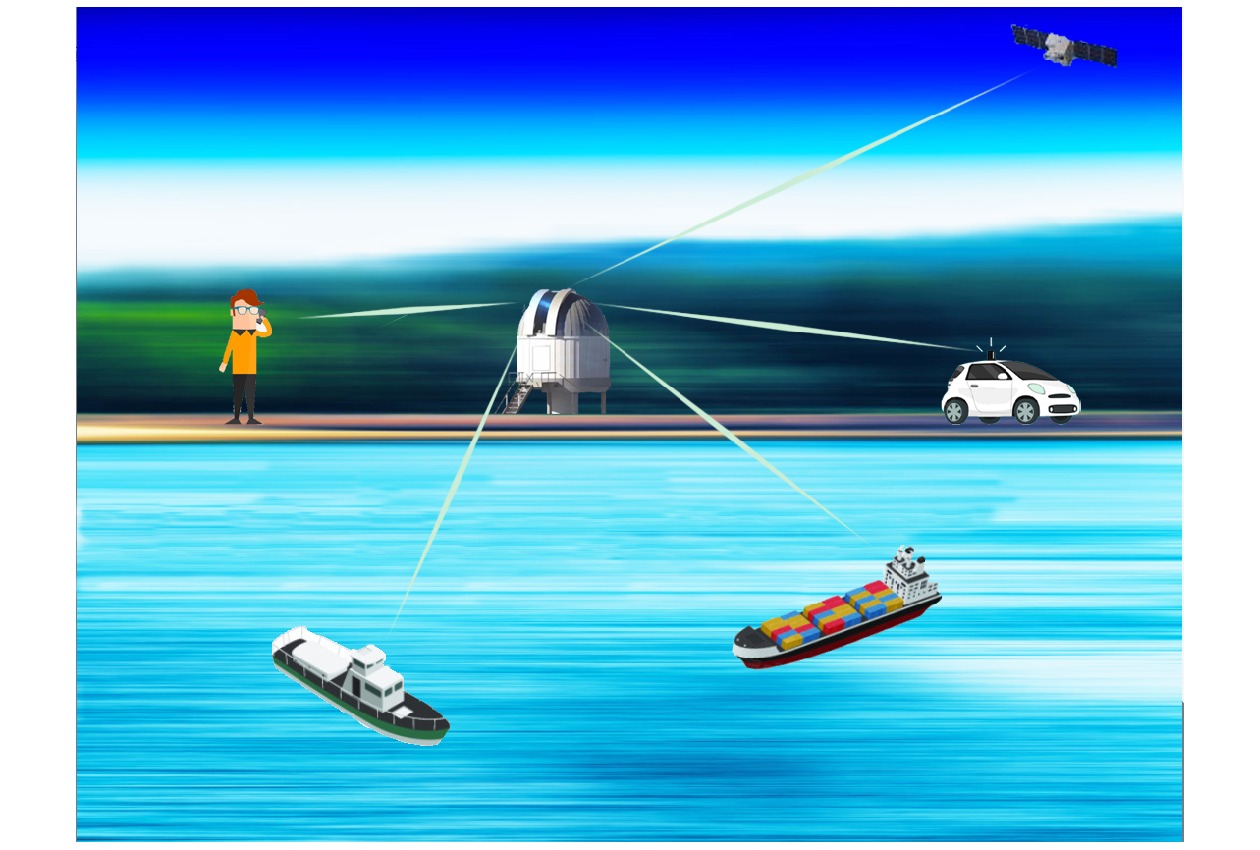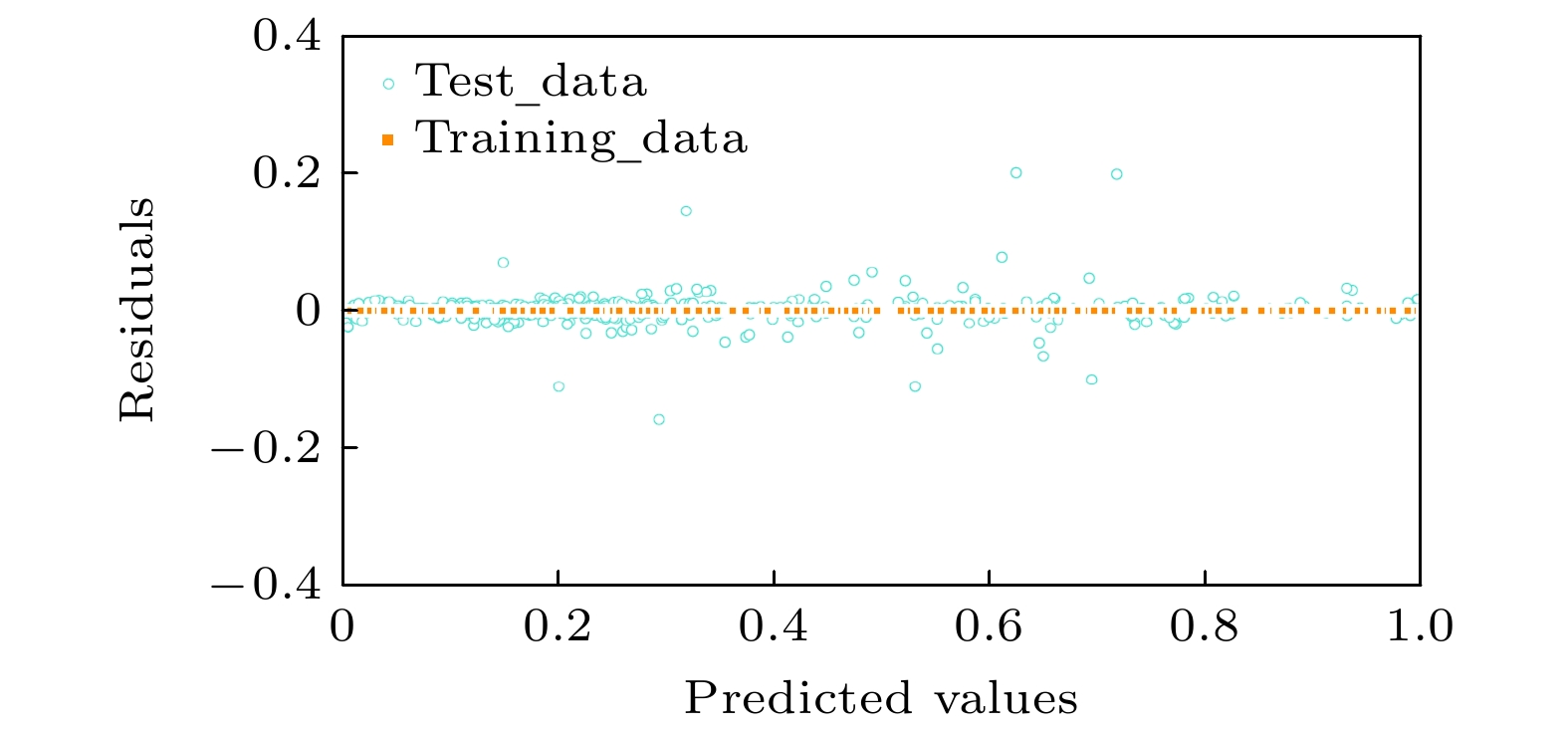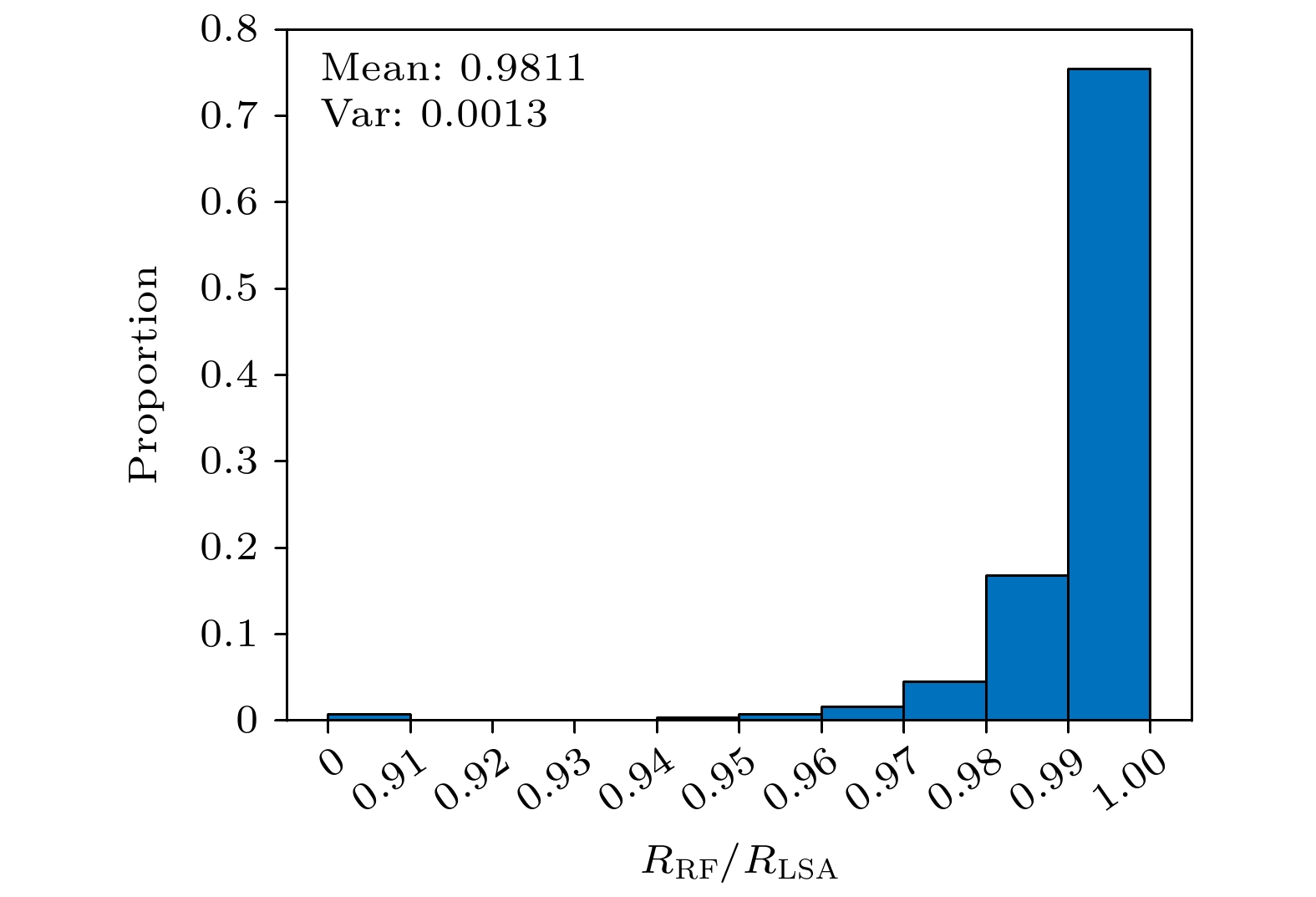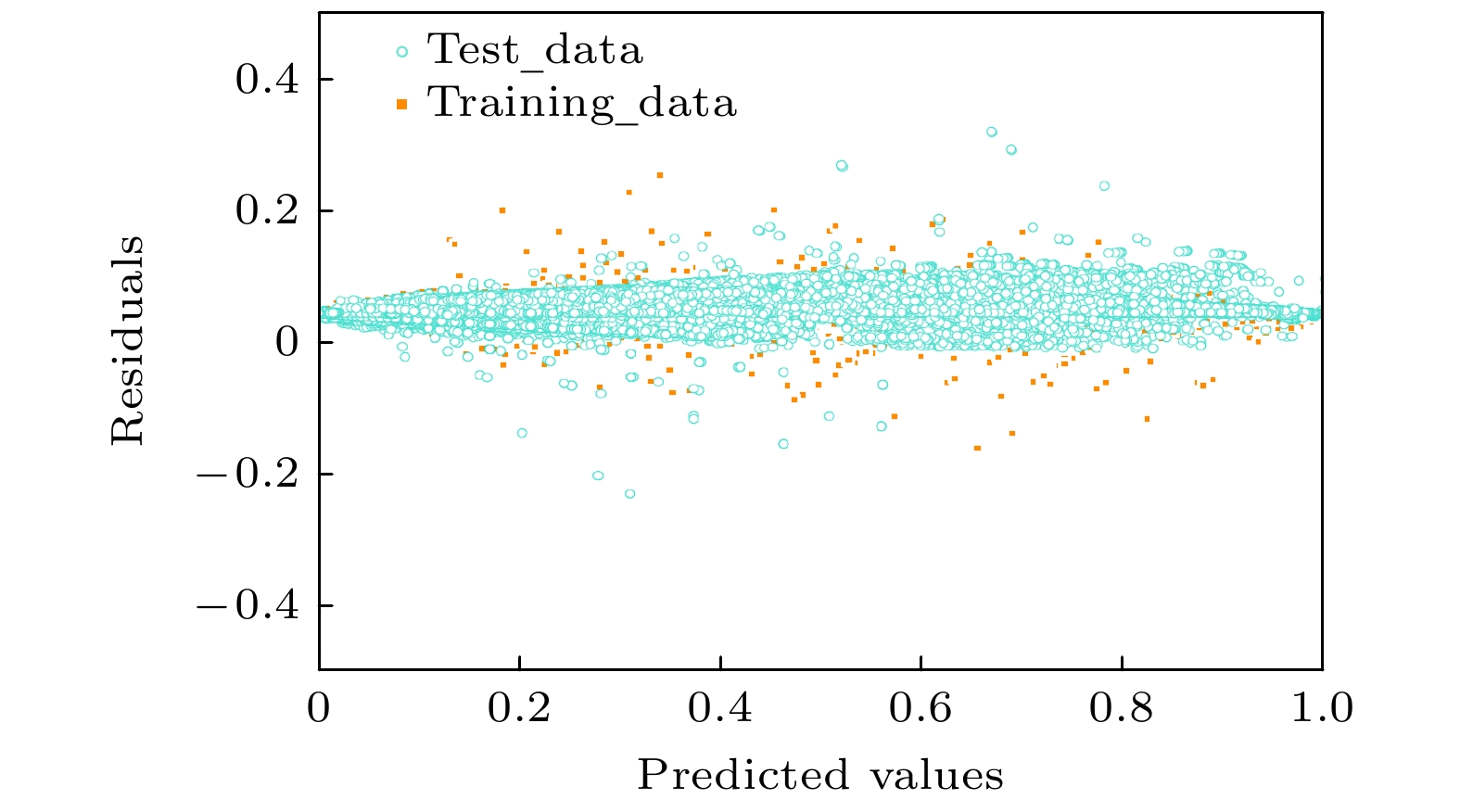-
量子密钥分发(quantum key distribution, QKD)结合一次一密的加密方式, 可以实现无条件安全的量子通信. 双场(twin-field, TF) QKD和测量设备无关(measurement-device-independent, MDI) QKD具有较高的安全性, 同时适合构建以测量端为中心的网络, 具有广阔的应用前景. 但在实际应用过程中, 参数配置对QKD性能有着极大影响, 而实际场景中存在着用户数量大、位置距离中心站点非对称、并且用户大部分处在实时移动中的特点. 面对上述实时的参数配置需求, 传统的参数优化方式将无法满足. 本文提出将监督机器学习算法应用于QKD参数优化配置中, 通过机器学习模型预测不同场景下TF和MDI两种常用协议的最优参数. 将神经网络、最近邻、随机森林、梯度提升决策树和分类回归决策树(classification and regression tree, CART)等监督学习模型进行对比, 结果显示CART模型在
$ {R^2} $ 等回归评估指标上均有最优表现. 在随机划分训练组、验证组情况下, 预测参数的密钥率与最优密钥率比值的均值在0.995以上; 在“超精度”和“超范围”两种极限情况下, 该均值仍能维持在0.988左右, 且在残差分析中具有较好的环境鲁棒性, 展现出较好的性能. 此外, 基于CART的新方案相较于传统方案在计算实时性表现上有很大提升, 将单次预测时间缩短至微秒量级, 很好地满足了通信方在移动状态下的实时通信需求.The parameter configuration of quantum key distribution (QKD) has a great effect on the communication effect, and in the practical application of the QKD network in the future, it is necessary to quickly realize the parameter configuration optimization of the asymmetric channel measurement-device-independent QKD according to the communication state, so as to ensure the good communication effect of the mobile users, which is an inevitable requirement for real-time quantum communication. Aiming at the problem that the traditional QKD parameter optimization configuration scheme cannot guarantee real-time, in this paper we propose to apply the supervised machine learning algorithm to the QKD parameter optimization configuration, and predict the optimal parameters of TF-QKD and MDI-QKD under different conditions through the machine learning model. First, we delineate the range of system parameters and evenly spaced (linear or logarithmic) values through experimental experience, and then use the traditional local search algorithm (LSA) to obtain the optimal parameters and take them as the optimal parameters in this work. Finally, we train various machine learning models based on the above data and compare their performances. We compare the supervised regression learning models such as neural network, K-nearest neighbors, random forest, gradient tree boosting and classification and regression tree (CART), and the results show that the CART decision tree model has the best performance in the regression evaluation index, and the average value of the key rate (of the prediction parameters) and the optimal key rate ratio is about 0.995, which can meet the communication needs in the actual environment. At the same time, the CART decision tree model shows good environmental robustness in the residual analysis of asymmetric QKD protocol. In addition, compared with the traditional scheme, the new scheme based on CART decision tree greatly improves the real-time performance of computing, shortening the single prediction time of the optimal parameters of different environments to the microsecond level, which well meets the real-time communication needs of the communicator in the movable state. This work mainly focuses on the parameter optimization of discrete variable QKD (DV-QKD). In recent years, the continuous variable QKD (CV-QKD) has developed also rapidly. At the end of the paper, we briefly introduce academic attempts of applying machine learning to the parameter optimization of CV-QKD system, and discuss the applicability of the scheme in CV-QKD system.-
Keywords:
- quantum key distribution /
- measurement-device-independent /
- classification and regression tree /
- parameter optimization
[1] Gisin N, Thew R 2007 Nat. Photonics. 1 165
 Google Scholar
Google Scholar
[2] Scarani V, Bechmann P H, Cerf N J, Dusek M, Lutkenhaus N, Peev M 2009 Rev. Mod. Phys. 81 1301
 Google Scholar
Google Scholar
[3] Wootters W K, Zurek W H 1982 Nature 299 802
 Google Scholar
Google Scholar
[4] Busch P, Heinonen T, Lathi P 2007 Phys. Rep. 452 155
 Google Scholar
Google Scholar
[5] Deutsch D, Ekert A, Jozsa R, Macchiavello C, Popescu S, Sanpera A 1996 Phys. Rev. Lett. 77 2818
 Google Scholar
Google Scholar
[6] Bennett C H, Brassard G 2014 Theoret. Comput. Sci. 560 7
 Google Scholar
Google Scholar
[7] 杨林轩, 苏志锟 2022 中国高新科技 11 82
 Google Scholar
Google Scholar
Yang L X, Su Z K 2022 China High and New Technol. 11 82
 Google Scholar
Google Scholar
[8] Lütkenhaus N 2000 Phys. Rev. A 61 052304
 Google Scholar
Google Scholar
[9] Acin A, Gisin N, Scarani V 2004 Phys. Rev. A 69 012309
 Google Scholar
Google Scholar
[10] Lydersen L, Wiechers C, Wittmann C, Elser D, Skaar J, Makarov V 2010 Nat. Photonics. 4 686
 Google Scholar
Google Scholar
[11] Lo H K, Curty M, Qi B 2012 Phys. Rev. Lett. 108 130503
 Google Scholar
Google Scholar
[12] Braunstein S L, Pirandola S 2012 Phys. Rev. Lett. 108 130502
 Google Scholar
Google Scholar
[13] Lucamarini M, Yuan Z L, Dynes J F, Shields A J 2018 Nature. 557 400
 Google Scholar
Google Scholar
[14] Takeoka M, Guha S, Wilde M M 2014 Nat. Commun. 5 5235
 Google Scholar
Google Scholar
[15] Wang X B, Yu Z W, Hu X L 2018 Phys. Rev. A 98 062323
 Google Scholar
Google Scholar
[16] Ma X, Zeng P, Zhou H 2018 Phys. Rev. X 8 031043
[17] 王华, 赵永利 2019 通信学报 40 168
 Google Scholar
Google Scholar
Wang H, Zhao Y L 2019 J. Commun. 40 168
 Google Scholar
Google Scholar
[18] Hughes R J, Morgan G L, Peterson C G 2000 J. Mod. Opt. 47 533
[19] Ren Z A, Chen Y P, Liu J Y, Ding H J, Wang Q 2020 IEEE Commun. Lett. 25 940
[20] Ding H J, Liu J Y, Zhang C M, Wang Q 2020 Quant. Inform. Proces. 19 1
 Google Scholar
Google Scholar
[21] Xu F, Xu H, Lo H K 2014 Phys. Rev. A 89 052333
 Google Scholar
Google Scholar
[22] Liu W, Huang P, Peng J, Fan J, Zeng G 2018 Phys. Rev. A 97 022316
 Google Scholar
Google Scholar
[23] Wang W, Lo H K 2019 Phys. Rev. A 100 062334
 Google Scholar
Google Scholar
[24] Lu F Y, Yin Z Q, Wang C, Cui C H, Teng J, Wang S, Chen W, Huang W, Xu B J, Guo G C, Han Z F 2019 JOSA B 36 B92
 Google Scholar
Google Scholar
[25] 陈以鹏, 刘靖阳, 朱佳莉, 方伟, 王琴 2022 物理学报 71 220301
 Google Scholar
Google Scholar
Chen Y P, Liu J Y, Zhu J L, Fang W, Wang Q 2022 Acta Phys. Sin. 71 220301
 Google Scholar
Google Scholar
[26] 王琴, 陈以鹏 2020 南京邮电大学学报 40 141
Wang Q, Chen Y P 2020 J. Nanjing University of Posts and Telecommun. 40 141
[27] Cao Y, Li Y H, Yang K X, et al. 2020 Phys. Rev. Lett. 125 260503
 Google Scholar
Google Scholar
[28] Zhou X Y, Zhang C H, Zhang C M, Wang Q 2019 Phys. Rev. A 99 062316
 Google Scholar
Google Scholar
[29] Wang W, Xu F, Lo H K 2019 Phys. Rev. X 9 041012
[30] Quinlan J R 1986 Mach. Learn. 1 81
[31] Rumelhart D E, Hinton G E, Williams R J 1986 Nature. 323 533
 Google Scholar
Google Scholar
[32] Gordon A D, Breiman L, Friedman J H, Olshen R A, Stone C J 1984 Biometrics. 40 874
 Google Scholar
Google Scholar
[33] 申媛媛, 邬锦雯, 刘鑫东 2020 科技管理研究 40 91
Shen Y Y, Wu T W, Liu X D 2020 Sci. Technol. Manage. Res. 40 91
[34] 刘勇洪, 牛铮, 王长耀 2005 遥感学报 9 405
 Google Scholar
Google Scholar
Liu Y H, Niu Z, Wang C Y 2005 J. Remote Sens. 9 405
 Google Scholar
Google Scholar
[35] 王辉, 张文杰, 刘杰, 陈林烽, 李泽南 2022 中国民航大学学报 40 35
 Google Scholar
Google Scholar
Wang H, Zhang W J, Liu J, Chen L F, Li Z N 2022 J. Civil Aviation University of China 40 35
 Google Scholar
Google Scholar
[36] 刘玉茹, 赵成萍, 臧军, 宁芊, 周新志 2017 计算机应用 37 57
Liu Y R, Zhao C P, Zang J, Ning Q, Zhou X Z 2017 Comput. Appl. 37 57
[37] S. Pirandola, Andersen U L, Banchi L, et al. 2020 Adv. Opt. Photonics 12 1012
 Google Scholar
Google Scholar
[38] Huang D, Liu S, Zhang L 2021 Photonics 8 511
 Google Scholar
Google Scholar
[39] Liu Z P, Zhou M G, Liu W B, Li C L, Gu J, Yin H L, Chen Z B 2022 Opt. Express 30 15024
 Google Scholar
Google Scholar
[40] Luo H, Wang Y J, Ye W, Zhong H, Mao Y Y, Guo Y 2022 Phys. B 31 020306
[41] Zhou M G, Liu Z P, Liu W B, Li C L, Bai J L, Xue Y R, Fu Y, Yin H L, Chen Z B 2022 Sci. Rep. 12 8879
 Google Scholar
Google Scholar
-
表 1 系统参数范围
Table 1. System parameter range.
参数 $ L $/km $ \Delta L $/km $ N $ $ \eta $ $ {Y_0} $ $ {e_{\text{d}}} $ 范围 0—300 0, 25, 50, 75, 100 109—1014 0.1—0.9 10–11—10–6 0.01—0.10 表 2 不同方案时间消耗对比
Table 2. Comparison of time loss between different schemes.
协议 决策树/s 神经网络/s KNN/s 传统/h TF-QKD 0.713 0.825 1.509 163 MDI-QKD 0.608 0.710 1.301 116 表 3 标准情况下模型结果评估
Table 3. Evaluation of the results under standard conditions.
协议 R2 MAE/10–3 MSE/10–5 TF-QKD 0.9916 3.42 8.05 MDI-QKD 0.9993 0.37 1.70 表 4 不同使用场景模型结果评估
Table 4. Evaluation of the results of different usage scenarios.
模型 $ {R^2} $ MAE/10–2 MSE/10–4 超范围 决策树 0.9529 1.64 8.75 RF 0.9494 1.68 9.12 梯度提升 0.8579 2.76 40.0 超精度 决策树 0.9659 1.14 3.52 RF 0.9654 1.15 3.54 梯度提升 0.9154 1.94 8.74 注: 粗体数据为该指标最好的结果. 表 5 不同方案时间消耗对比
Table 5. Comparison of time loss between different schemes.
协议 RF/s 决策树/s 梯度提升树/s 传统/h TF-QKD 1.426 0.713 6.748 163 MDI-QKD 1.221 0.608 5.631 116 -
[1] Gisin N, Thew R 2007 Nat. Photonics. 1 165
 Google Scholar
Google Scholar
[2] Scarani V, Bechmann P H, Cerf N J, Dusek M, Lutkenhaus N, Peev M 2009 Rev. Mod. Phys. 81 1301
 Google Scholar
Google Scholar
[3] Wootters W K, Zurek W H 1982 Nature 299 802
 Google Scholar
Google Scholar
[4] Busch P, Heinonen T, Lathi P 2007 Phys. Rep. 452 155
 Google Scholar
Google Scholar
[5] Deutsch D, Ekert A, Jozsa R, Macchiavello C, Popescu S, Sanpera A 1996 Phys. Rev. Lett. 77 2818
 Google Scholar
Google Scholar
[6] Bennett C H, Brassard G 2014 Theoret. Comput. Sci. 560 7
 Google Scholar
Google Scholar
[7] 杨林轩, 苏志锟 2022 中国高新科技 11 82
 Google Scholar
Google Scholar
Yang L X, Su Z K 2022 China High and New Technol. 11 82
 Google Scholar
Google Scholar
[8] Lütkenhaus N 2000 Phys. Rev. A 61 052304
 Google Scholar
Google Scholar
[9] Acin A, Gisin N, Scarani V 2004 Phys. Rev. A 69 012309
 Google Scholar
Google Scholar
[10] Lydersen L, Wiechers C, Wittmann C, Elser D, Skaar J, Makarov V 2010 Nat. Photonics. 4 686
 Google Scholar
Google Scholar
[11] Lo H K, Curty M, Qi B 2012 Phys. Rev. Lett. 108 130503
 Google Scholar
Google Scholar
[12] Braunstein S L, Pirandola S 2012 Phys. Rev. Lett. 108 130502
 Google Scholar
Google Scholar
[13] Lucamarini M, Yuan Z L, Dynes J F, Shields A J 2018 Nature. 557 400
 Google Scholar
Google Scholar
[14] Takeoka M, Guha S, Wilde M M 2014 Nat. Commun. 5 5235
 Google Scholar
Google Scholar
[15] Wang X B, Yu Z W, Hu X L 2018 Phys. Rev. A 98 062323
 Google Scholar
Google Scholar
[16] Ma X, Zeng P, Zhou H 2018 Phys. Rev. X 8 031043
[17] 王华, 赵永利 2019 通信学报 40 168
 Google Scholar
Google Scholar
Wang H, Zhao Y L 2019 J. Commun. 40 168
 Google Scholar
Google Scholar
[18] Hughes R J, Morgan G L, Peterson C G 2000 J. Mod. Opt. 47 533
[19] Ren Z A, Chen Y P, Liu J Y, Ding H J, Wang Q 2020 IEEE Commun. Lett. 25 940
[20] Ding H J, Liu J Y, Zhang C M, Wang Q 2020 Quant. Inform. Proces. 19 1
 Google Scholar
Google Scholar
[21] Xu F, Xu H, Lo H K 2014 Phys. Rev. A 89 052333
 Google Scholar
Google Scholar
[22] Liu W, Huang P, Peng J, Fan J, Zeng G 2018 Phys. Rev. A 97 022316
 Google Scholar
Google Scholar
[23] Wang W, Lo H K 2019 Phys. Rev. A 100 062334
 Google Scholar
Google Scholar
[24] Lu F Y, Yin Z Q, Wang C, Cui C H, Teng J, Wang S, Chen W, Huang W, Xu B J, Guo G C, Han Z F 2019 JOSA B 36 B92
 Google Scholar
Google Scholar
[25] 陈以鹏, 刘靖阳, 朱佳莉, 方伟, 王琴 2022 物理学报 71 220301
 Google Scholar
Google Scholar
Chen Y P, Liu J Y, Zhu J L, Fang W, Wang Q 2022 Acta Phys. Sin. 71 220301
 Google Scholar
Google Scholar
[26] 王琴, 陈以鹏 2020 南京邮电大学学报 40 141
Wang Q, Chen Y P 2020 J. Nanjing University of Posts and Telecommun. 40 141
[27] Cao Y, Li Y H, Yang K X, et al. 2020 Phys. Rev. Lett. 125 260503
 Google Scholar
Google Scholar
[28] Zhou X Y, Zhang C H, Zhang C M, Wang Q 2019 Phys. Rev. A 99 062316
 Google Scholar
Google Scholar
[29] Wang W, Xu F, Lo H K 2019 Phys. Rev. X 9 041012
[30] Quinlan J R 1986 Mach. Learn. 1 81
[31] Rumelhart D E, Hinton G E, Williams R J 1986 Nature. 323 533
 Google Scholar
Google Scholar
[32] Gordon A D, Breiman L, Friedman J H, Olshen R A, Stone C J 1984 Biometrics. 40 874
 Google Scholar
Google Scholar
[33] 申媛媛, 邬锦雯, 刘鑫东 2020 科技管理研究 40 91
Shen Y Y, Wu T W, Liu X D 2020 Sci. Technol. Manage. Res. 40 91
[34] 刘勇洪, 牛铮, 王长耀 2005 遥感学报 9 405
 Google Scholar
Google Scholar
Liu Y H, Niu Z, Wang C Y 2005 J. Remote Sens. 9 405
 Google Scholar
Google Scholar
[35] 王辉, 张文杰, 刘杰, 陈林烽, 李泽南 2022 中国民航大学学报 40 35
 Google Scholar
Google Scholar
Wang H, Zhang W J, Liu J, Chen L F, Li Z N 2022 J. Civil Aviation University of China 40 35
 Google Scholar
Google Scholar
[36] 刘玉茹, 赵成萍, 臧军, 宁芊, 周新志 2017 计算机应用 37 57
Liu Y R, Zhao C P, Zang J, Ning Q, Zhou X Z 2017 Comput. Appl. 37 57
[37] S. Pirandola, Andersen U L, Banchi L, et al. 2020 Adv. Opt. Photonics 12 1012
 Google Scholar
Google Scholar
[38] Huang D, Liu S, Zhang L 2021 Photonics 8 511
 Google Scholar
Google Scholar
[39] Liu Z P, Zhou M G, Liu W B, Li C L, Gu J, Yin H L, Chen Z B 2022 Opt. Express 30 15024
 Google Scholar
Google Scholar
[40] Luo H, Wang Y J, Ye W, Zhong H, Mao Y Y, Guo Y 2022 Phys. B 31 020306
[41] Zhou M G, Liu Z P, Liu W B, Li C L, Bai J L, Xue Y R, Fu Y, Yin H L, Chen Z B 2022 Sci. Rep. 12 8879
 Google Scholar
Google Scholar
计量
- 文章访问数: 7875
- PDF下载量: 99
- 被引次数: 0















 下载:
下载:











